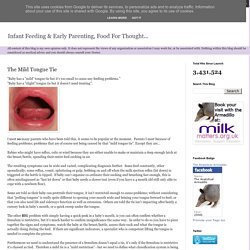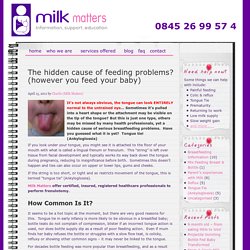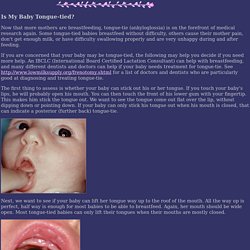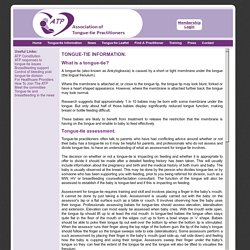

Is Your Baby a Tether-Berg or a Tether-Floe? - The Myofunctional Center, llc. Nice.org. Rethinking Tongue Tie Anatomy: Anterior vs Posterior Is Irrelevant — DrGhaher... Unfortunately, what I have encountered when most practitioners treat tongue tie is that the procedure is done incompletely.

This post will describe how to completely treat a tongue tie to completely release any tension on the tongue. After treating over a thousand babies with breastfeeding problems, it has become clear to me that our previous understanding of the anatomy of tongue tie is inaccurate. In my training, we only were taught to release the thin membrane of a tongue tie if restriction was noted (this was in the setting of speech problems, not breastfeeding). Most practitioners who haven't done a significant number of tongue tie procedures also tend to just snip this front membrane. Parents are impressed because of the lack of bleeding, and the practitioners willingly do it because it carries no risk. The Myths About Painful Breastfeeding — DrGhaheri.com. Throughout this blog, I will do my best to try and address what is commonly said by doctors, dentists and lactation consultants who don't understand the correlation between tongue-tie and lip-tie and poor breastfeeding.

I think that we must first disprove what they think they know. I think these myths are born out of a complete lack of education, and with time, hopefully we won't hear them as frequently. I've compiled a list of phrases that are often used when a mom is experiencing pain or other difficulties during breastfeeding. I will try to show you why they are inaccurate and how knowing them before you talk to your doctor can be empowering. Tongue ties come in various severities.... - Bobby Ghaheri MD.
The Mild Tongue Tie. "Baby has a "mild" tongue tie but it's too small to cause any feeding problems.

" "Baby has a "slight" tongue tie but it doesn't need treating". I meet so many parents who have been told this, it seems to be popular at the moment. Parents I meet because of feeding problems; problems that are of course not being caused by that "mild tongue tie". Except they are... Babies who might have reflux, colic or wind because they are either unable to make or maintain a deep enough latch at the breast/bottle, spending their entire feed sucking in air. The resulting symptoms can be wide and varied, complicating diagnosis further. Analytical Armadillo: Upper Lip Tie, Fall Guy... It is now common to hear "both lips should flange like a duck".

This actually isn't true, and as lactation consultants many have commented we often see this "duck positioning" when baby is shallow. Whilst Catherine often writes about tongue tie, I was interested to hear whether she felt lip ties were a significant cause of breastfeeding issues. She replied: "I think the upper lip frenulum is infrequently an issue when breastfeeding. I am concerned that the term "lip tie" causes parents to be overly concerned about this issue and could increase doctors' skepticism of frenotomy.
" Sucking blister on the top lip So we have a baby gripping hard with its lips, if the tongue is thrusting, rather than undulating (as we frequently see with a tongue tie), it can cause the baby to move back and forth like a piston. Add together tight grip of the lips + moving = friction blister on upper lip/babies slipping off the breast as their own suck pushes them backwards. The hidden cause of feeding problems? (however you feed your baby) - milk matters. It’s not always obvious, the tongue can look ENTIRELY normal to the untrained eye… Sometimes it’s pulled into a heart shape or the attachment may be visible on the tip of the tongue?

But this is just one type, others may be missed by many health professionals, yet a hidden cause of serious breastfeeding problems. Have you guessed what it is yet? Tongue tie! (Ankyloglossia) If you look under your tongue, you might see it is attached to the floor of your mouth with what is called a lingual frenum or frenulum. If the string is too short, or tight and so restricts movement of the tongue, this is termed “tongue tie” (Ankyloglossia).
Milk Matters offer certified, insured, registered healthcare professionals to perform frenulotomy. How to Examine a Baby for Tongue-Tie or Lip-Tie — DrGhaheri.com. The only purpose of this post is to demonstrate how to examine a baby who may have a tongue-tie or lip-tie.

Future posts will help to explain the symptoms of intraoral restrictions that can impact breastfeeding. Our first year of medical school includes proper examination technique. For instance, if you don't know where to put your stethoscope, you might miss a heart murmur. Unfortunately, we aren't instructed on how to examine a baby who is having breastfeeding problems. Catherine Watson Genna, IBCLC.
Now that more mothers are breastfeeding, tongue-tie (ankyloglossia) is on the forefront of medical research again.

Some tongue-tied babies breastfeed without difficulty, others cause their mother pain, don't get enough milk, or have difficulty swallowing properly and are very unhappy during and after feeding. If you are concerned that your baby may be tongue-tied, the following may help you decide if you need more help. An IBCLC (International Board Certified Lactation Consultant) can help with breastfeeding, and many different dentists and doctors can help if your baby needs treatment for tongue-tie. Tongue-tie Information and Infant Feeding Issues. What is a tongue-tie?

A tongue-tie (also known as Ankyloglossia) is caused by a short or tight membrane under the tongue (the lingual frenulum). Where the membrane is attached at, or close to the tongue tip, the tongue tip may look blunt, forked or have a heart shaped appearance. However, where the membrane is attached further back the tongue may look normal. Research suggests that approximately 1 in 10 babies may be born with some membrane under the tongue. But only about half of those babies display significantly reduced tongue function, making breast or bottle feeding difficult. These babies are likely to benefit from treatment to release the restriction that the membrane is having on the tongue and enable to baby to feed effectively. Tongue tie.